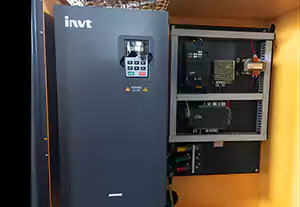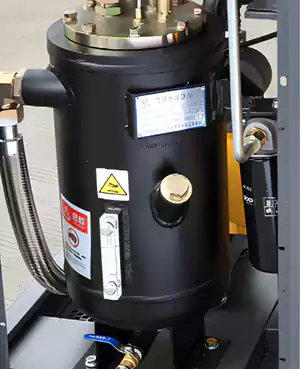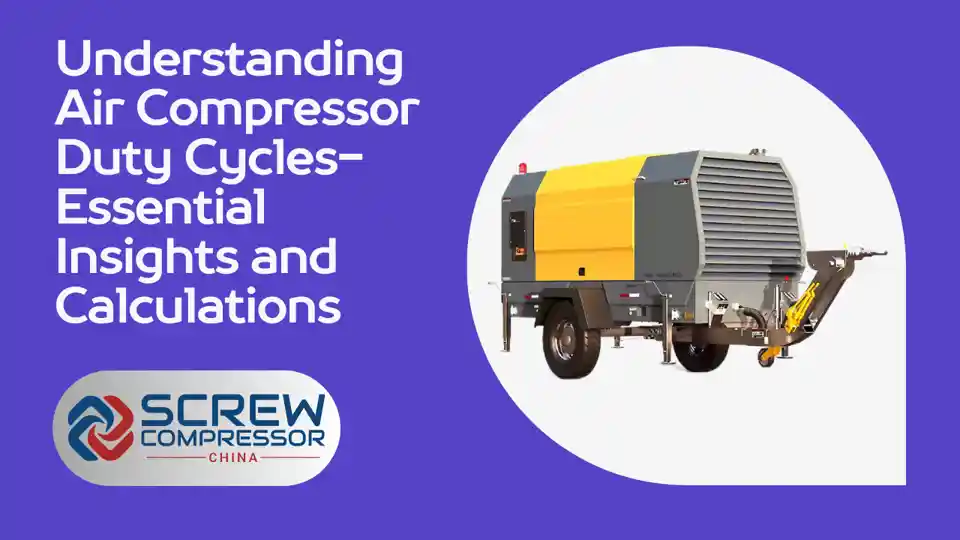Air compressors are vital in various industries, ranging from manufacturing to automotive repair. Understanding the duty cycle of an air compressor can significantly enhance its efficiency and longevity. This article explores the concept of compressor duty cycles, how to calculate them, and their importance in daily operations.
The duty cycle is a critical factor in determining the suitability of an air compressor for a specific application. It represents the percentage of time an air compressor can operate without overheating, relative to the total time it is running. For instance, a compressor with a 50% duty cycle can run for 30 minutes within an hour before needing to cool down for the remaining 30 minutes. Conversely, a 100% duty cycle compressor can run continuously without the risk of overheating.

Duty cycles are determined by several factors, including the compressor’s design, cooling system efficiency, ambient temperature, and operating pressure. Reciprocating compressors typically have lower duty cycles compared to rotary screw compressors due to their design and cooling limitations. Understanding your application’s air demand and matching it with a compressor that has an appropriate duty cycle is crucial for optimal performance and longevity.
What is a Compressor Duty Cycle?
The duty cycle of an air compressor indicates the percentage of time it can operate within an hour without overheating and needing to rest. It is a crucial factor for users to consider to ensure optimal performance and avoid undue wear on the compressor.
The duty cycle is expressed as a percentage, representing the ratio of the compressor’s running time to the total cycle time (running time + rest time). For example, a compressor with a 60% duty cycle can operate for 36 minutes within an hour, followed by a 24-minute rest period. This cycle repeats continuously to prevent the compressor from overheating and sustaining damage.
Several factors influence a compressor’s duty cycle, including:
- Compressor type: Reciprocating compressors generally have lower duty cycles (50-60%) compared to rotary screw compressors (100%).
- Cooling system efficiency: More effective cooling systems allow for higher duty cycles.
- Ambient temperature: Higher ambient temperatures reduce the duty cycle as the compressor struggles to dissipate heat.
- Operating pressure: Higher operating pressures put more strain on the compressor, lowering the duty cycle.
Selecting a compressor with the appropriate duty cycle for your application is essential. Overworking a compressor beyond its rated duty cycle can lead to premature wear, reduced efficiency, and potential breakdowns. On the other hand, choosing a compressor with an excessively high duty cycle for a low-demand application can result in higher initial costs and energy inefficiencies.
Compressor Run Time and Total Cycle Time
The duty cycle is often calculated by dividing the compressor’s run time by its total cycle time. For a deeper dive into what factors to consider during these calculations, visit What You Need to Know About Air Compressor Duty Cycles.
To calculate the duty cycle, you need to determine the compressor’s running time and the total cycle time. The running time is the duration the compressor operates before needing to rest, while the total cycle time is the sum of the running time and the rest time.
For example, let’s consider a compressor that runs for 15 minutes and then rests for 5 minutes. The total cycle time is 20 minutes (15 minutes running + 5 minutes resting). To calculate the duty cycle, divide the running time by the total cycle time and multiply by 100:
Duty Cycle = (Running Time ÷ Total Cycle Time) × 100 = (15 minutes ÷ 20 minutes) × 100 = 0.75 × 100 = 75%
In this case, the compressor has a 75% duty cycle, meaning it can operate for 45 minutes within an hour (75% of 60 minutes) before needing to rest for 15 minutes.
It’s essential to consider the compressor’s rated duty cycle when planning its operation. Running a compressor beyond its specified duty cycle can lead to overheating, reduced performance, and potential damage. Always consult the manufacturer’s specifications and guidelines to ensure the compressor is operating within its designed limits.
Calculating the Duty Cycle
Understanding how to accurately calculate the duty cycle of your air compressor can help in optimizing its use and extending its life.
Duty Cycle Calculation
For practical guidance on calculating your compressor’s duty cycle, you can read How to Calculate Duty Cycle, which provides a step-by-step approach.
To calculate the duty cycle of your air compressor, follow these steps:
- Determine the compressor’s running time (T_run): This is the duration the compressor operates before needing to rest, usually specified by the manufacturer.
- Determine the compressor’s rest time (T_rest): This is the duration the compressor needs to cool down before it can operate again, also specified by the manufacturer.
- Calculate the total cycle time (T_total): Add the running time and the rest time.T_total = T_run + T_rest
- Calculate the duty cycle: Divide the running time by the total cycle time and multiply by 100.Duty Cycle = (T_run ÷ T_total) × 100
For example, if a compressor has a running time of 30 minutes and a rest time of 10 minutes:
T_total = 30 minutes + 10 minutes = 40 minutesDuty Cycle = (30 minutes ÷ 40 minutes) × 100 = 75%
This means the compressor has a 75% duty cycle and can operate for 45 minutes within an hour (75% of 60 minutes) before needing to rest for 15 minutes.

It’s crucial to adhere to the manufacturer’s specified duty cycle to ensure optimal performance and longevity of the compressor. Overworking a compressor beyond its rated duty cycle can lead to overheating, reduced efficiency, and potential damage.
Efficiency Considerations
The efficiency of a compressor is directly tied to how well it is managed according to its duty cycle. Effective management can reduce wear and increase longevity. For comprehensive insights into the efficiency calculations, check out Compressor power calculation.
Compressor efficiency is a measure of how effectively the compressor converts input power into useful compressed air output. It is influenced by several factors, including the compressor type, operating conditions, and maintenance practices. Managing the compressor according to its duty cycle is one of the key aspects of optimizing efficiency.
When a compressor operates within its rated duty cycle, it can maintain optimal performance levels and minimize energy waste. Overworking a compressor beyond its duty cycle can lead to increased heat generation, reduced efficiency, and accelerated wear on components. This not only results in higher energy consumption but also shortens the compressor’s lifespan, leading to more frequent maintenance and replacement costs.
To maximize compressor efficiency, consider the following:
- Select a compressor with the appropriate duty cycle for your application to avoid over- or under-sizing.
- Operate the compressor within its rated duty cycle, allowing for sufficient rest periods.
- Implement a regular maintenance schedule to keep the compressor in optimal condition, including cleaning or replacing air filters, checking oil levels, and inspecting components for wear.
- Monitor the compressor’s performance using sensors and data logging to identify any deviations from optimal efficiency levels.
- Optimize the compressed air system as a whole, minimizing leaks, properly sizing piping, and using appropriate air treatment equipment.
By effectively managing the compressor according to its duty cycle and implementing best practices for efficiency, you can reduce energy consumption, extend the compressor’s lifespan, and minimize overall operating costs.
Enhancing Compressor Efficiency
Optimizing air compressor efficiency not only saves energy but also reduces operational costs. Here’s how you can achieve better efficiency.
Extending Duty Cycle
Extending the duty cycle of an air compressor involves various strategies, including adjusting the run and rest periods to better match operational demands. For more on how to extend the duty cycle, explore What Is an Air Compressor Duty Cycle & How Do I Calculate It?.
While it’s essential to operate a compressor within its rated duty cycle to ensure optimal performance and longevity, there are strategies to extend the duty cycle and improve overall efficiency. Some of these strategies include:
- Upgrading the cooling system: Implementing a more efficient cooling system, such as an aftercooler or a variable speed fan, can help dissipate heat more effectively, allowing for longer running times and shorter rest periods.
- Optimizing operating conditions: Ensuring the compressor operates in a cool, well-ventilated environment can help reduce heat buildup and extend the duty cycle. Additionally, maintaining the proper operating pressure and minimizing pressure drops in the system can reduce the strain on the compressor.
- Implementing a variable speed drive (VSD): VSDs allow the compressor to adjust its output based on the actual air demand, reducing the number of start/stop cycles and extending the overall duty cycle.
- Proper sizing and selection: Choosing a compressor with the appropriate capacity and duty cycle for your application helps avoid overworking the compressor and ensures efficient operation.
- Regular maintenance: Adhering to a strict maintenance schedule, including cleaning or replacing air filters, checking oil levels, and inspecting components for wear, can help maintain optimal performance and extend the compressor’s duty cycle.

It’s important to note that extending the duty cycle should be done within the limits specified by the manufacturer. Always consult the manufacturer’s guidelines and recommendations before making any modifications to the compressor’s operation or setup. Overextending the duty cycle beyond the designed limits can lead to increased wear, reduced efficiency, and potential damage to the compressor.
Compressor Power and Efficiency Calculations
Accurately calculating the power needs and efficiency levels of your compressor can lead to significant savings. This detailed guide provides an in-depth look at power calculations for compressors.
Calculating compressor power and efficiency is crucial for optimizing energy consumption and minimizing operating costs. The power required by a compressor depends on several factors, including the air flow rate, operating pressure, and compressor efficiency.
To calculate the power consumption of a compressor, use the following formula:
Power (kW) = (Q × P) ÷ (η × 36.74)
Where:
- Q = Air flow rate (cubic feet per minute, CFM)
- P = Operating pressure (pounds per square inch, PSI)
- η = Compressor efficiency (typically 0.7-0.9 for industrial compressors)
- 36.74 is a constant derived from the conversion of units
For example, if a compressor delivers 100 CFM at 100 PSI with an efficiency of 0.8:
Power (kW) = (100 CFM × 100 PSI) ÷ (0.8 × 36.74) = 340.5 kW
To calculate the efficiency of a compressor, use the following formula:
Efficiency (η) = (Q × P) ÷ (Power × 36.74)
Using the same example as above, if the compressor consumes 340.5 kW of power:
Efficiency (η) = (100 CFM × 100 PSI) ÷ (340.5 kW × 36.74) = 0.8
By accurately calculating the power consumption and efficiency of your compressor, you can:
- Identify opportunities for energy savings by optimizing operating conditions or upgrading to more efficient equipment.
- Compare the performance of different compressors to select the most suitable one for your application.
- Monitor the compressor’s performance over time to detect any deviations from optimal efficiency levels, indicating the need for maintenance or repairs.
- Estimate the operating costs of the compressed air system and allocate budgets accordingly.
Regularly assessing the power consumption and efficiency of your compressor helps ensure that the system is operating at peak performance while minimizing energy waste and costs.
Frequently Asked Questions
Q1: What does a 100% duty cycle mean for an air compressor?
A1:A 100% duty cycle means that the compressor can operate continuously without the need for a cooldown period, ideal for heavy-duty applications.
Q2: How can I improve my compressor’s duty cycle?
A2:Improving a compressor’s duty cycle can be achieved by ensuring it is properly sized for the application, maintaining it regularly, and monitoring its performance closely.
Q3: Why is knowing the duty cycle important?
A3:Understanding the duty cycle helps in planning the operational schedule of the compressor, ensuring it delivers maximum efficiency without risk of overheating.
In summary, the duty cycle is a critical aspect of air compressor operation. By understanding and calculating it accurately, you can significantly enhance the efficiency and lifespan of your compressor. For further reading on rigorous compressor calculations and comparisons of different methods, consider visiting Compressor Calculations: Rigorous Using Equation of State vs. Shortcut Method.
Meta Description: Discover the importance of understanding air compressor duty cycles, learn how to calculate them, and explore ways to enhance compressor efficiency for optimal performance.
